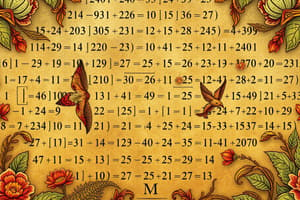Podcast
Questions and Answers
Which of the following best describes the purpose of a variable in algebra?
Which of the following best describes the purpose of a variable in algebra?
- It represents a letter that can never change.
- It represents a constant number.
- It represents a number that can change in value. (correct)
- It represents an equation.
What is the result of factoring the expression $x^2 - 16$?
What is the result of factoring the expression $x^2 - 16$?
- $(x + 8)(x + 2)$
- $(x - 4)(x + 4)$ (correct)
- $(x - 8)(x + 8)$
- $(x + 4)(x + 4)$
Which of these equations represents a linear equation?
Which of these equations represents a linear equation?
- $y = \sqrt{x}$
- $y = 2x^3$
- $y = 3x + 2$ (correct)
- $y = x^2 + 2$
What is the primary difference between a ratio and a rate?
What is the primary difference between a ratio and a rate?
What type of equation is represented by the expression $ax^2 + bx + c = 0$?
What type of equation is represented by the expression $ax^2 + bx + c = 0$?
Which of the following notations is NOT a valid way to express a ratio?
Which of the following notations is NOT a valid way to express a ratio?
Which operation is NOT typically used in manipulating algebraic expressions?
Which operation is NOT typically used in manipulating algebraic expressions?
If the ratio of boys to girls in a class is 3:2, how many girls are there if there are 12 boys?
If the ratio of boys to girls in a class is 3:2, how many girls are there if there are 12 boys?
Flashcards are hidden until you start studying
Study Notes
Algebra
- Definition: A branch of mathematics dealing with symbols and the rules for manipulating those symbols.
- Key Concepts:
- Variables: Letters representing numbers (e.g., x, y).
- Expressions: Combinations of variables and constants (e.g., 3x + 2).
- Equations: Mathematical statements that two expressions are equal (e.g., 2x + 3 = 7).
- Inequalities: Statements indicating one value is larger or smaller than another (e.g., x < 5).
- Operations:
- Addition/Subtraction: Combining or removing values.
- Multiplication/Division: Scaling values or distributing them.
- Factoring: Breaking down expressions into simpler components (e.g., x^2 - 9 = (x + 3)(x - 3)).
- Linear Equations: Equations that graph as straight lines (e.g., y = mx + b).
- Quadratic Equations: Second-degree polynomial equations (e.g., ax^2 + bx + c = 0), solved using factoring, completing the square, or the quadratic formula.
Ratio and Rate
- Ratio:
- Definition: A comparison of two quantities, showing the relative sizes.
- Notation: Can be expressed as a fraction (a/b), with a colon (a:b), or in words ("a to b").
- Types:
- Part-to-Part: Compares different parts (e.g., 2:3).
- Part-to-Whole: Compares a part to the total (e.g., 2 out of 5, or 2:5).
- Rate:
- Definition: A specific type of ratio that compares two different units (e.g., speed = distance/time).
- Common Examples:
- Speed: Miles per hour (mph), kilometers per hour (km/h).
- Density: Mass per unit volume (e.g., grams per cubic centimeter).
- Unit Price: Cost per item or cost per unit.
- Conversions: Important in calculations involving rates; ensure units are consistent.
- Proportions: An equation stating that two ratios are equal (e.g., a/b = c/d), often used to solve for unknowns in ratio problems.
Algebra
- Algebra is focused on symbols and rules for manipulating these symbols, essential for solving mathematical problems.
- Variables represent unknown quantities and are denoted by letters such as x and y.
- Expressions combine variables and constants, exemplified by the equation 3x + 2.
- Equations assert the equality of two expressions; for instance, 2x + 3 = 7 indicates that both sides are equivalent.
- Inequalities express a relationship where one quantity is greater or less than another, such as x < 5.
- Basic operations in algebra include addition and subtraction for combining values, and multiplication and division for scaling and distributing values.
- Factoring involves breaking down expressions into simpler components; for example, x^2 - 9 can be factored into (x + 3)(x - 3).
- Linear equations are first-degree equations that graph as straight lines, generally written in the form y = mx + b.
- Quadratic equations are second-degree polynomial equations, structured as ax^2 + bx + c = 0, solvable through factoring, completing the square, or the quadratic formula.
Ratio and Rate
- A ratio compares two quantities, demonstrating their relative sizes and can be shown as a fraction (a/b), using a colon (a:b), or in words (a to b).
- There are two main types of ratios:
- Part-to-Part ratios, which compare different parts of a whole (example: 2:3).
- Part-to-Whole ratios, which compare a specific part to the entire amount (example: 2 out of 5, or 2:5).
- A rate is a specific kind of ratio that compares different units, such as speed (distance/time).
- Common examples of rates include:
- Speed expressed in miles per hour (mph) or kilometers per hour (km/h).
- Density represented as mass per unit volume, like grams per cubic centimeter.
- Unit price, demonstrating cost per item or cost per unit.
- Unit consistency is crucial in calculations involving rates to ensure accurate conversions.
- Proportions illustrate that two ratios are equivalent (example: a/b = c/d), frequently utilized to find unknown values in ratio problems.
Studying That Suits You
Use AI to generate personalized quizzes and flashcards to suit your learning preferences.




